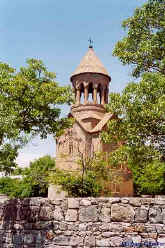|

|
To reach the city of Yeghvard,
follow the main road turning slightly left.
Pass under the underpass signposted for Ashtarak and Arzni.
Entering the outskirts of Yeghvard, go to the end of the divided
bit of roadand turn right at 16.5 km (shop “Presents”on right).
Continue
1.8 km |
|
Another left fork from Eghvard leads
to Nor
Yerznka,
founded in 1949. It is also reachable from Ashtarak
main road (at 10.5
km take right off-ramp signposted signposted “Egvard”). At 12.3 km turn left (no sign) on asphalt road.
At 13.9 km turn left (signposted “Nor Yerznka”),
asphalt. Going uphill
through
the
village,
|

|
|
to the edge of the city (“Commercial
Shop” on left), turn sharply left and 50 meters thereafter zig right
again. This is the road
that leads to Buzhakan and Aparan. Yeghvard was a
large, tidy, ancient village with the small, two-story S.
Astvatsatsin (“Mother of God”) Church (1301 or 1321), steeple
visible from afar,
and an important 5/6th century ruined
basilica
about 350 m SSW of it.
|
|
one reachs the volcanic crater of Mt.
Ara, named after the handsome early Armenian
god/hero/king killed
and brought back to life under mythological circumstances involving
Queen Semiramis (but less elegantly called in Perso-Russian times
Garniyarigh - "Torn Stomach" in Turkish).
Built into a mossy cave, complete with sacred spring, is the
shrine of Kuys Varvara (the Virgin Barbara), also known as Tsaghkevank, with saint’s tomb, altar, ferns, and candle vendors. |